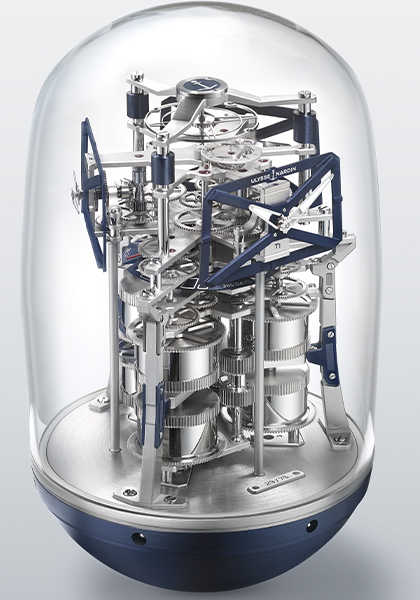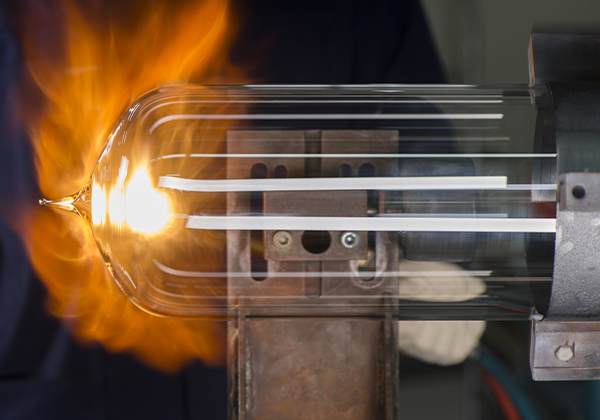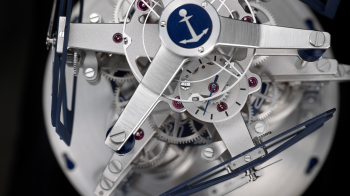To celebrate its 175th anniversary, Ulysse Nardin takes clockmaking into the realms of imagination by reinventing the chronometer. UFO might be a table or desk clock, but it is so many other things besides. It’s a swinging mechanical depiction of the movement of the waves. It is a triple-timed zone amalgam of the past, present and future. Once again, Ulysse Nardin has launched something completely unexpected – a new addition to its cabinet of curiosities, inspired by innovation and exploration, the seas and the skies.
Exactly 175 years ago, Ulysse Nardin was renowned for its incredibly accurate and extremely reliable ships’ watches and marine chronometers. These were prize-winning machines, scooping up the first prizes in the chronometry competitions of both Geneva’s and Neuchâtel’s observatories. Close to 50 admiralties were kept on course, successfully navigating the high seas thanks to Ulysse Nardin’s superlative craftsmanship.
How does one celebrate the future of the brand, while staying true to the desire to make the best time-measuring tools — the challenge Ulysse Nardin set himself in 1846?
“Reissuing a watch from the past by reusing vintage codes was not part of our creative intentions for this anniversary object. On the contrary, we wanted to reverse the trend and make a leap forward of 175 years, rather than a leap backward. We always look ahead. We wondered what a marine chronometer designed in 2196 would be like,” explains Patrick Pruniaux, CEO of Ulysse Nardin.

With its 663 components driving three time-zone indications, the UFO is a futuristic interpretation of what Ulysse Nardin’s designers, engineers, and watchmakers think a marine chronometer would look like in 175 years’ time. This UFO has been designed to guide the explorers of the future, whichever seas they may sail.
Taking the ocean as the ultimate inspiration, the movement of the UFO is that of the waves made mechanical. The entire structure of the clock is built on an imbalance, on a gentle swing which recalls the ebb and flow of the tides, the perpetual movement of the ocean. The secret of the balance is its blue half-spherical aluminum base, which contains a tungsten mass. The base and glass bell are joined by a bayonet mounting system, which looks similar to the old systems of marine chronometers from which the glass could be unscrewed.
Whereas marine chronometers were housed in wooden boxes and set on gimbals to counteract the effect of the ship’s constant sway, Ulysse Nardin reverses this. Here it is the object itself that makes waves when it is nudged gently. Weighing 7.2kg, the UFO swings up to 60° from its axis – for a total amplitude of 120° – and the engineers have accurately calculated the centre of the gravity/mass/inertia ratio, which allows UFO to swing neither too fast nor too slowly and without significantly affecting the operation of the balance.
The UFO is mesmeric enough, but attention should also be paid to the ovoid glass bell under which it sways. It has been created by Romain Montero, a 26-year-old artisan glass blower who works for Verre et Quartz, a technical glass-blowing workshop located on the shores of Switzerland’s Lake Neuchâtel. He had the responsibility for handcrafting for every one of the 75 numbered limited-edition UFO glass covers.

“The biggest challenge was the overall aesthetics of the glass tube. To get 50 spotless glass bells, I had to blow out three times the number, 150 bells. You need to blow gently, as if you want to make a soap bubble. Even so, the glass is imperfect at the base and is sensitive to micro-vibrations during blowing, but there is beauty in those imperfections and small flaws,” explains Montero.
To manufacture each 3mm-thick tube, it was necessary to stretch the glass when it was still hot, for more than 45 minutes, using only the naked eye, on a traditional glass-maker's lathe at temperatures of up to 1,500° Celsius. The total process takes almost half a day of work: cutting of the glass, blowing, checking the blowing and the measurements, furnace annealing, cutting again, lamination, final and visual inspection, and then cleaning.
“From the moment you heat the glass, you disrupt the atoms. It’s the heat that creates the disruption. It’s inevitable. This creates weaknesses in the material that can lead to spontaneous breakage, which is not what you want. You need to release the tension to achieve perfection,” Montero explains.
The most successful voyages require an experienced crew. For this particular journey, Ulysse Nardin decided to collaborate with the celebrated clockmaker Maison L’Epée, who has been manufacturing traditional clocks since 1839 and is now famed for bringing the fantastical imaginings of MB&F’s CEO Max Büsser to life.
Comprising 663 components, and with one year of power reserve supplied by its six extra-large barrels, and a balance wheel rim that reaches the spectacular diameter of 49mm, UFO displays the time on three trapezoidal dials, which are so complex it takes 28 hours to manufacture just eight of them. Having three dials allows the owner to display three different time zones at once, seen from three different angles.
The XXL brass balance wheel beats at 0.5Hz and the objective is twofold: to maintain an exceptionally long power reserve of one year and to make the movement of the object like a meditation; gentle and soothing with ample time to admire one alternation (half oscillation) per second. The addition of a dead-beat seconds display adds to that sense of this table clock being a meditation on time, with the passing of each second uniformly marked.
UFO comes in a presentation case of aged wood that looks as if it could be a treasure chest washed up on a beach; something that appears to come from the past but with a message from the future contained within. Inside, you will find UFO, but also its operating instructions, its warranty card and a special place for its winding key. It takes 40 wind-up turns with a square-end stainless steel key to wind up the mechanism for one year. Each dial has its wind-up notch, which is also used to the set the time (four notches in total, one for winding up and one for each time zone wound up using a single key).




